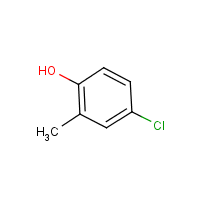4-Chloro-2-methylphenol
Agent Name
4-Chloro-2-methylphenol
CAS Number
1570-64-5
Formula
C7-H7-Cl-O
Major Category
Other Classes

Synonyms
2-Methyl-4-chlorophenol; 4-Chloro-2-cresol; 4-Chloro-o-cresol; Phenol, 4-chloro-2-methyl-; o-Cresol, 4-chloro-; p-Chloro-o-cresol; [ChemIDplus] 5-Chloro-2-hydroxytoluene; PCOC; [CAMEO] 4-Chlor-ortho-kresol; 4-Chloro, 2-methyl phenol; 4-CHLORO-ORTHO-CRESOL; P.C.O.C.; Para chloro 2-cresol; Para chloro 2-methyl phenol; Para chloro ortho cresol; Para Chloro ortho cresol; Para orthochlorocresol; PARA-CHLORO-ORTHO-CRESOL; [IUCLID] UN2669; UN3437
Category
Chlorophenols
Description
Pale yellow solid; [HSDB] Dark red solid; [CAMEO] White to brown solid; [CHEMINFO] White or brown crystalline solid; [MSDSonline]
Sources/Uses
Used to make herbicides (Mecoprop, MCPA, and MCPB), as an additive tracer for resist plasma etching, and as a disinfectant; [HSDB] "Metabolite of 2-methyl-4-chlorophenoxyacetic acid & other phenoxyacetic acid herbicides." [ChemIDplus] Used as a closed system intermediate in phenoxy herbicide production; [IUCLID]
Comments
A skin, eye, and mucous membrane irritant; [CAMEO] A corrosive substance that can cause injury to the skin and eyes, based on animal studies; [CHEMINFO] A corrosive substance that can cause injury to the skin, eyes, and respiratory tract; Can cause pulmonary edema; [ICSC] Chlorocresol causes contact urticaria (both immune and non-immune); [Kanerva, p. 219] A corrosive substance that can cause injury to the skin, eyes, and respiratory tract; Inhalation may cause chemical pneumonitis; [MSDSonline] See "CHLOROPHENOLS." See "p-Chloro-m-cresol."
Biomedical References
Exposure Assessment
Vapor Pressure
0.024 mm Hg
Lethal Concentration
LC50 (rat) = 900 mg/m3/4h
Explanatory Notes
Flash point = 78 deg C; [CHEMINFO] The Guide in the Emergency Response Guidebook is for "Chlorocresols, solid." VP from ChemIDplus;
Adverse Effects
Toxic Pneumonitis
Yes
Neurotoxin
Other CNS neurotoxin
Hepatotoxin
Hepatoxic (a) from occupational exposure (secondary effect) or (b) in animal studies or in humans after ingestion
Nephrotoxin
Yes
Dermatotoxin
Skin burns
Diseases, Processes, and Activities Linked to This Agent
Diseases
Occupational diseases associated with exposure to this agent:
Processes
Industrial Processes with risk of exposure: